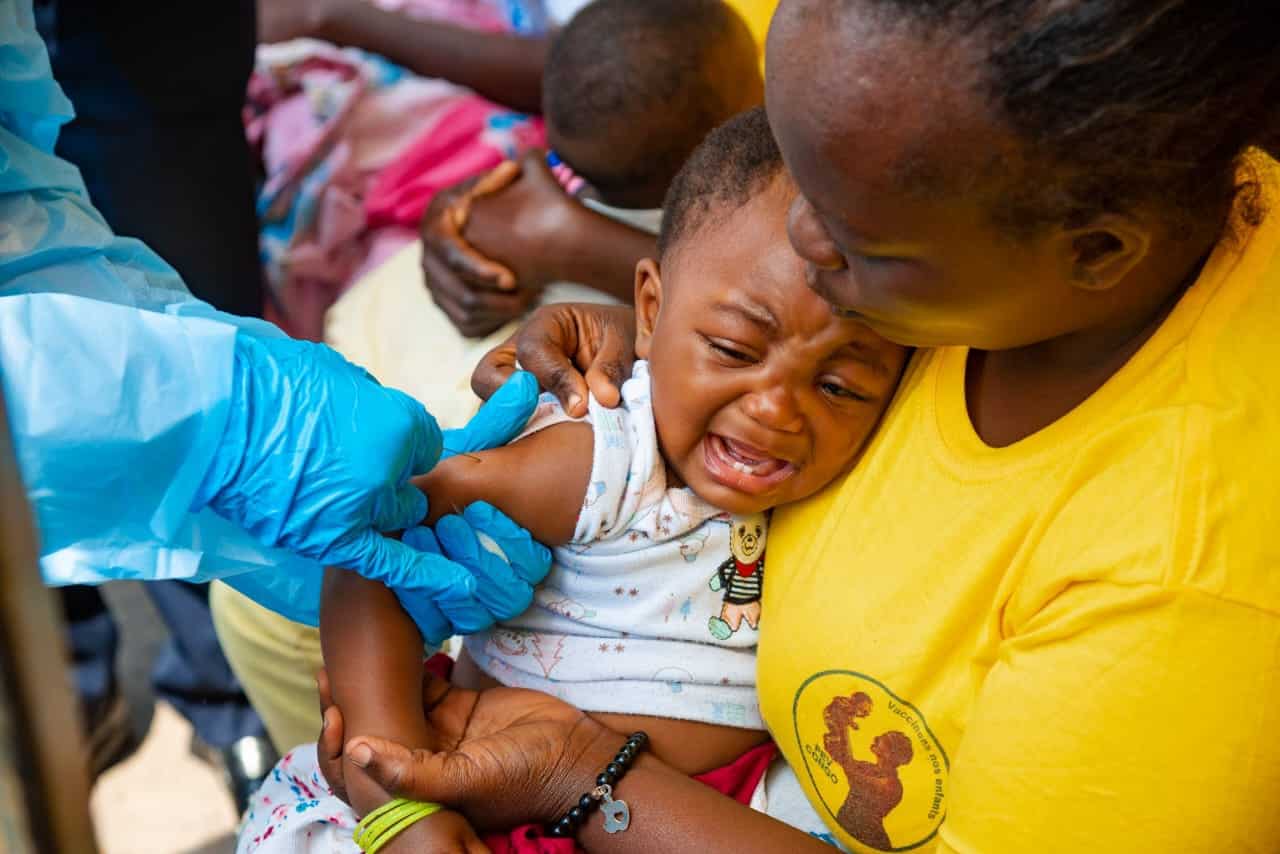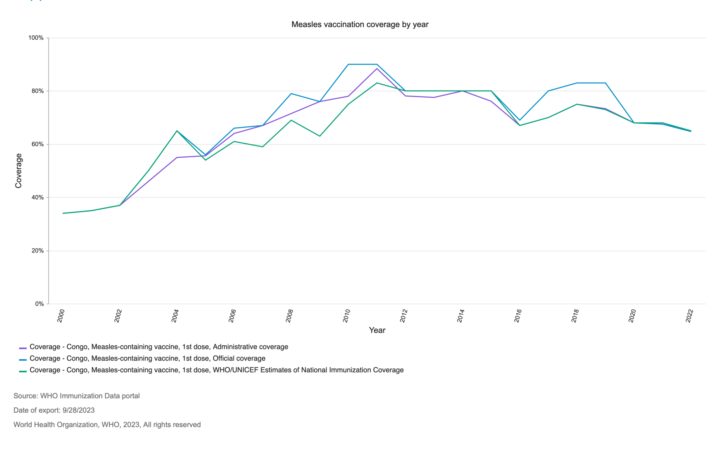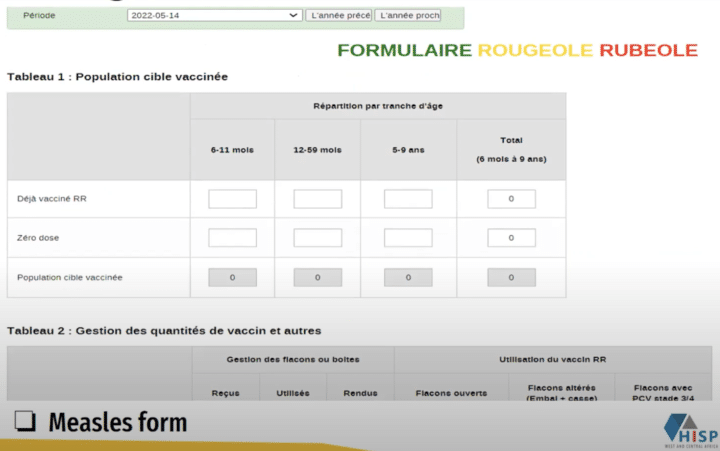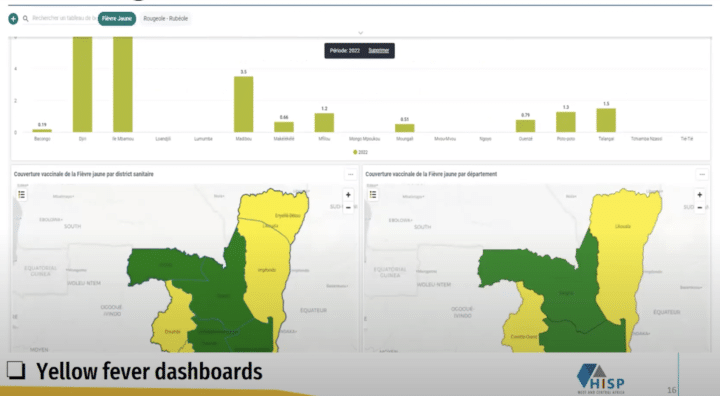
Streamlining immunization data management for effective response to measles and yellow fever outbreaks in Congo using DHIS2
The Congolese Ministry of Health, supported by GAVI, achieved vaccination coverage of 107% for measles and 93% for yellow fever in its first use of DHIS2 for the national vaccine program
In 2022, a large-scale measles outbreak in Congo affected nearly 150,000 people, causing the deaths of 1,875, including 78 children under the age of 5 years. Measles is endemic in Congo with regular outbreaks that affect thousands of people, especially children. In 2020 and 2021, Congo suffered similar recurrent measles outbreaks with about 80,450 and 54,471 reported cases respectively.
Measles is a highly contagious viral disease capable of infecting 9 out of 10 exposed and unvaccinated persons. Fortunately, the transmission of measles can be prevented with appropriate vaccination. The WHO projects that at least 95% routine coverage with two doses of a measles vaccine is required to interrupt community transmission. In Congo, measles vaccination coverage is estimated at 65%, much lower than the WHO target. As such, routine measles vaccination campaigns have been conducted over the years in a bid to curtail the deadly disease. However, the nationwide measles and yellow fever vaccination campaign conducted in the wake of the 2022 outbreak, was the first to be implemented using DHIS2.

Using the DHIS2 platform to collect and manage campaign data helped the MoH to achieve an estimated 107% coverage for measles and rubella vaccines as well as 93% yellow fever vaccination coverage–a significant improvement over previous campaigns. The platform further assisted the health authorities in improving the overall immunization data quality by unifying the hitherto separate systems for recording routine and non-routine immunization campaign data. The DHIS2 system also helped the campaign implementers to produce detailed and accurate reports of their activities in only two weeks–compared to several months in previous exercises–thereby facilitating timely analysis and decision-making and planning for follow-up campaigns.
"I am more than satisfied with the way data was managed through DHIS2 for this campaign, I want all routine EPI tools digitized in DHIS2"
Strengthening data quality and data use with DHIS2 for aggregation, validation and visualization
The initial 2022 measles and yellow fever campaign in Congo was conducted over one week in June. This campaign differed from previous exercises carried out to combat the measles outbreak in one particular way: the use of DHIS2 for data collection, aggregation, and analysis. This was based on recommendations by GAVI to the Ministry of Health (MoH). The need to adopt a reliable system for the campaign was further galvanized by the concurrent outbreak of yellow fever in Pointe-Noire province, worsening public health and straining the healthcare systems.
Like most previous campaigns, the national immunization exercise required people to come into the healthcare facilities close to them for vaccination. Designated staff members at the facilities collected required data on paper forms during the vaccination. At the end of the day, these records are reviewed by the data manager at the facility for any errors. If the data is without any errors, the records are sent upward through the health system hierarchy, first to the health area level for review and collation, then to the district levels for validation and entry into DHIS2. The target was to get all the daily vaccination and stock data to the district level at the end of each day, however, the data were sometimes sent to the districts by the following day.
At the district level, vaccination and logistic data from the different health areas are reviewed once more by a district-level data manager before they can be entered into DHIS2 by the district EPI staff, who is also responsible for entering routine EPI data into the DHIS2 system. Once entered into DHIS2, the data is aggregated from the healthcare facility level, through the health areas, and district levels, to the national level. Using DHIS2, district and national teams could thus easily monitor the reported data for completeness and intervene with specific health areas or facilities to resolve any issues with data quality or delays in reporting. The data was also visualized in custom DHIS2 dashboards, allowing stakeholders at all levels to efficiently monitor campaign progress and drill down to specific organizational unit levels to inform decisions.

During the campaign, vaccinators at the health facilities also recorded vaccine stock data and doses administered daily in designated data collection forms. From the DHIS2 dashboards, program managers were able to guide the distribution of vaccines to facilities where they were needed the most. DHIS2 was also used to collect information on Adverse Effects Following Immunization (AEFI) for investigation and potential follow-up. Additionally, the DHIS2 data helped the MoH staff plan data validation and supervision trips to the field, ensuring that good quality data was maintained in the system for decision support. It also helped identify needs and inform planning for the follow-up joint measles and yellow fever vaccination campaign carried out in August of the same year. The DHIS2 instance configured for this campaign was also integrated with Congo’s national DHIS2-based Health Management Information System (HMIS), making the immunization campaign data available for wider health decision-making and planning.
Financial support for this implementation was provided by GAVI, while HISP West and Central Africa (HISP WCA) provided technical support. This included design and configuration of the campaign instance, including reporting forms, indicators, and dashboards in collaboration with the MoH EPI team, and using data from the existing EPI system to map target populations for the campaign. In addition, HISP WCA designed training modules and carried out capacity-building activities with data entry staff and EPI program officers to support the effective use of DHIS2 during the campaign.

Strengthening nationwide immunization data systems: A result of the successful use of DHIS2 for measles vaccination campaign
Adopting DHIS2 as the platform to drive the 2022 joint measles and yellow fever vaccination campaigns in Congo, spurred a push by government departments to digitize other aspects of the national healthcare systems using DHIS2. Following the successful campaigns, the National EPI Director mandated the digitization of all EPI tools throughout the country in DHIS2. This directive has led to the configuration of DHIS2 for all routine immunization programs in DRC, followed by training of trainers at the district level to strengthen the capacity of healthcare workers for data management in DHIS2. The participants are, in turn, required to step the training down to the health areas and facilities over time.
Furthermore, a follow-up yellow fever vaccination campaign was conducted in the most affected districts in March 2023, using the DHIS2 platform. Similarly, in May 2023, the team configured the platform to support other immunization campaigns planned for the rest of the year. Program managers and team leads have also expressed satisfaction with how much easier the DHIS2 platform has made their routine tasks, contributing to health protection and promotion in Congo.
"I'm impressed by DHIS2, because of its various functionalities and the speed of data processing through its analysis tools at every level of our pyramid. I think it's an ideal tool in the data management of our program. In addition to this, there is the seniority component and the expertise we have gained in managing data from the campaign against yellow fever and measles"
This article is based on a presentation by Koffi Siliadin, of HISP West and Central Africa, at the 2023 DHIS2 Annual Conference. You can watch a recording on the DHIS2 YouTube channel.


